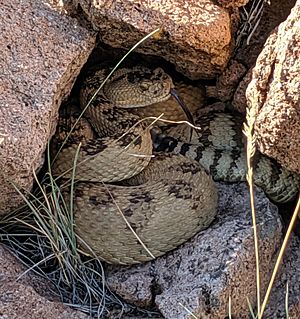Great Basin rattlesnake facts for kids
Quick facts for kids Great Basin rattlesnake |
|
|---|---|
 |
|
| Scientific classification | |
| Genus: |
Crotalus
|
| Species: |
lutosus
|
| Synonyms | |
|
|
The Great Basin rattlesnake (Crotalus lutosus) is a type of venomous snake found in the Great Basin area of the United States. It's a pit viper, which means it has special heat-sensing pits on its face to help it find prey.
Contents
What's in a Name?
Scientists give every animal a special two-part name, like a first and last name, so everyone around the world knows exactly which animal they are talking about. The Great Basin rattlesnake's scientific name is Crotalus lutosus. A scientist named Laurence Monroe Klauber first officially described this snake in 1930. The name "lutosus" means "muddy," which probably refers to its color!
Grand Canyon Rattlesnake Connection
For a while, the Grand Canyon rattlesnake (C. abyssus) was considered the same as the Great Basin rattlesnake. However, scientists now often consider them separate, though closely related, types of rattlesnakes.
How to Spot a Great Basin Rattlesnake
These rattlesnakes can grow to be about 2 to 4 feet (66 to 121 cm) long, but they rarely get longer than 3 feet (1 meter). Male snakes usually grow a bit larger than females.
Scales and Colors
One special thing about these snakes is their scales. They have three or more scales called internasal scales right between their nostrils.
Their skin color can be buff, light gray, light brown, olive brown, or yellowish brown. This "muddy" color helps them blend in with their surroundings. They have a pattern of 32 to 49 dark brown or black blotches on their back. These blotches often have lighter centers and edges, and they can be a bit irregular in shape. As the snakes get older, their patterns might fade, or the blotches might become completely black.
Where Do They Live?
The Great Basin rattlesnake lives in the United States, mainly in the Great Basin region. You can find them in parts of Idaho, Utah, Arizona (especially near the Colorado River and the north rim of the Grand Canyon), almost all of Nevada, and eastern California (east of the Sierra Nevada). They also live in parts of southern and eastern Oregon.
Preferred Homes
These snakes love dry and barren places. They are often found on hills, mountain sides, and old lake beds. They seem to prefer sunny spots among rocks and boulders. You might also see them in open deserts, low foothills, and even in alfalfa fields or valley floors.
What Do They Eat?
The Great Basin rattlesnake is a predator. It hunts and eats a variety of animals. Their diet includes amphibians like frogs, other reptiles, birds and bird eggs, and small mammals.
Reproduction and Life Cycle
Great Basin rattlesnakes give birth to live young. They don't lay eggs. A mother snake can have anywhere from 3 to 13 babies at a time.
Conservation Status
The Great Basin rattlesnake is a protected species in the state of Utah. This means there are rules in place to help keep their populations healthy and safe.

